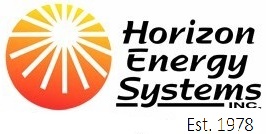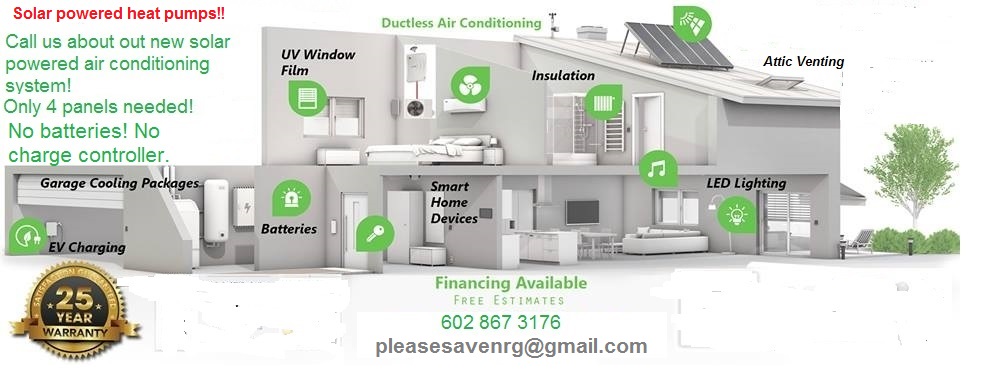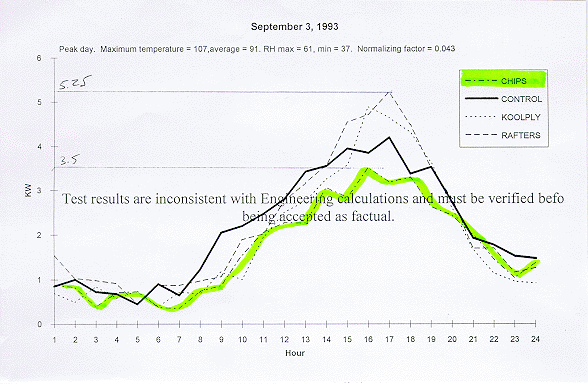 Contact us: 602-867-3176
Contact us: 602-867-3176 Contact us: 602-867-3176
Contact us: 602-867-3176 
PROPRIETARY PATENTED SUSTAINABLE BUILDING PRODUCTS
't workA study of heat movement,
radiant barriers and insulation:
A research study performed by Brad Lindsay
Horizon Energy Systems
Copyright 1991-2018
ARE WE LIVING IN OVENS?
Homes in hot climates are unknowingly designed and built to act as Dutch ovens, baking the people living in them. Homes built in hot climates using today's building standards are collecting, storing, and, unfortunately, re-emitting heat energy, long after the sun goes down. Not only is this phenomenon of heat re-emission expensive for the home owner because of the costs for cooling a home, it's also uncomfortable.
Re-emission of heat energy can be easily experienced by entering an attic at 9:00 p.m. after a hot day. Even though the sun has been down for several hours and the ambient temperature is under 80f, the attic temperature is still above 125f. What could be the source of this heat? Hot air trapped in the attic? There is not enough volume or mass in air alone to store this many BTU's for so long. The roof? Tracking roof surface temperature with a thermography scanner shows the roof matching outdoor ambient temperature 40 minutes after the sun goes down. Placing a thermometer into the insulation will reveal the source…stored heat in the insulation. Since the purpose of insulation is to slow heat movement, it takes hours for heat to escape once the insulation gets hot.
It is very important to keep the insulation as cool as possible during the hot summer months in a hot environment! This makes venting, no, let me make this clear: adequate venting, an integral part of energy design.
WHY ARE HOMES IN HOT CLIMATES BUILT THIS WAY?
Two reasons: First, when fossil fuels were cheap and seemingly endless, generating electricity was inexpensive. This fostered monthly electric bills under $50 dollars and minimal interest in energy conservation. Homes were built accordingly.
Recent energy audits performed on homes here in Phoenix, Arizona, illustrate the chronological history of conserving energy or lack thereof. Many homes built in the 40's had little or no insulation in the walls or ceiling.
Second, insulation levels used in today's homes began in cold climates where heat moves out of a home and is lost mostly through convective and conductive losses. A layer of insulation in the attic resisted these heat losses and saved energy. The term "R-factor" was then created by insulation manufacturers to give their product a gauge for measuring heat loss. The “R” stands for resistance to heat flow. Since heat moves in three identifiable paths and the R factor addresses only two (conduction and convection), it seems silly to place emphasis on raising the “R factor” of a building.
Driven by rising energy costs year after year, we began to look for ways to conserve. A higher R-factor seemed to be the answer since it was proven to work in cold climates for heat loss. I've watched the local trend to pile more and more insulation in the attic and increase the R-factor in walls to attempt to radiant heat.
The standard in the 80's was R-19 in the attic and R-11 in the walls. It was then recommended to increase the walls to R-19 by using a 6” wall stud and R-30 in the attics. The “more insulation is better” train of thought continues today as some home builders are now offering R-42 in the attic. This theory does not work in hot climates were heat becomes trapped inside insulation.
INSULATION IN HOT CLIMATES
Does fibrous insulation work for radiant heat? To some extent. However, during the hottest part of the day, it can be confirmed that the temperature of the insulation one inch below the surface is 15 to 30 degrees hotter than the hottest air in the attic!
COMMON BELIEFS
The sun heats the roof, the roof heats the air in the attic which, left unchecked, will move into the home. Insulation having an R-factor or resistance to heat flow sounds like a pretty good idea when placed just above the area being cooled…or is it? What about the radiant heat being emitted from the plywood roof deck? Does insulation slow radiant heat? To some degree. But not as well as a reflective surface as we will see.
REALITY
If insulation absorbs radiant heat and is hotter than the attic air, what then is an appropriate method for reducing this overlooked form of heat gain? A reflective surface with a low emissivity placed between the source of heat(the roof), and the insulation.
This reflective building product is now recognized as a Radiant Barrier System (RBS). RBS placed correctly in a home can significantly reduce heat movement and increase the overall efficiency and comfort. However, years of research and infrared scanning has proven that RBS placed incorrectly can increase the energy consumption in a home. Refer to fig 1 below.

Figure 1 illustrates the results from testing Radiant Barrier Systems (RBS), on four identical, unoccupied homes. This graph represents a twenty four hour usage pattern of 4 identical unoccupied homes. Each home has a 4 ton heat pump which was metered to show consumption of electricity.
RADIANT BARRIER TESTINGThe testing was performed and monitored by Arizona Public Service Co. and Horizon Energy Systems. The black line is the control home without a RBS. The other lines track three different types and placements of RBS in a residential home. The graph is based on energy consumption across a 24 hour period. All homes are identical, unoccupied and have been tested to have equal duct losses and infiltration factors by Charles Gohman of the Arizona Department of Commerce Energy Office.
RAFTER RBS
This home has the RBS stapled between the roof rafters, up against the bottom of the plywood roofing material or the roof deck. This seems like a logical placement for the RBS as the roof is the source the incoming radiant heat. An obvious drawback to this design is the difficulty in trying to install it. Cramped quarters, wasted , ripped material and inaccessibility are a few problems. (Many RBS installations done this way last only a few years then rips from the staples and falls off)
More importantly is the effect the rafter RBS had on energy consumption. Not only is this configuration difficult to install, it caused the home to consume more energy than the control home without a RBS.
PLYWOOD LAMINATED WITH RBS
This unique RBS (Koolply, now called Techshield) is applied (laminated) to the roof decking material prior to the construction of the home. No additional labor is required for installation as the RBS is in place as the roof is being nailed down. This is an obvious benefit from an installation point of view. However, like the rafter RBS, laminated plywood RBS caused this home to consume more energy than the control house without a RBS.
RBS CHIPS
Radiant Barrier Chips are a flexible, metalized film product which are cut into small, dimpled squares. These reflective chips are then blown into the attic from a hose which completely covers the existing insulation where they form a protective shield several layers deep. This guards against the incoming infrared heat source generated by the hot roof deck. The same principle works in the winter when heat is being emitted from the top of the insulation. Note the RBS Chip was the only RBS to illustrate an energy savings over all the other homes tested.
UNDERSTANDING EMISSIVITY
In order to understand the chart above, an understanding of emissivity is necessary. Emissivity is the ability for an object to release "emit" radiant heat. The lower the emissivity, the more difficult it is for heat to leave the surface in radiant form. This why chrome tools in your toolbox and car door handles get too hot to touch when exposed to the sun.
Most paints emit in the .90 range which is very high. (See Fig 1.2 next page) Chrome has an emissiviy or "E" value of .05. It will take more time for a chrome bumper to get as hot as one painted black but the low emissivity of chrome traps the heat making it much hotter. The low E value of chrome prevents the absorbed heat from escaping makes the surface hot. This is why black chrome solar panels provide hotter water than panels painted flat black. Black chrome will take a little longer to get hot, but once it does, the low E selective surface traps heat in the absorber which in turn transfers it through conduction into the water passages. Fig. 1.2 lists the emissivity of various substrates and building materials.
Fig 1.2 EMISSIVITY OF VARIOUS COMMON MATERIALS
Material Emissivity value
Gold, polished .03
Metalized Film Radiant Barrier .04
Silver, polished .04
Chrome .05
Aluminum, polished .04
oxidized .78
Brass, polished .04
oxidized .61
Iron, polished .21
oxidized .69
Copper, polished .05
oxidized .78
Human skin .98
EMISSIVITY OF BUILDING MATERIALS
Wood .95
Glass .94
Paint, average of 16 colors .94
Brick, common red .93
Concrete .92
Plaster, rough coat .91
Source: Handbook of Chemistry
NOW LET’S LOOK AT THE ATTICS AGAIN
Using Fig 1.2 as a reference, lets get back to the different RBS applications and see how the emissivity affects energy consumption.

RAFTERS
The RBS placed at the rafter reflects the incoming infrared (IR) back to the surface of the roof. This in turn heats the roof hotter than it would have been without the RBS. The hot roof heats the air in the attic (unless vented at each end of the rafter), which then increases the temperature of the insulation which in turn increases heat flow into the home. As the sun moves towards the horizon, it becomes apparent in Fig.1 that the heat is trapped inside attic, raising the demand for electricity. The RBS is reflecting this heat back into the home instead of allowing it to escape through the roof.
This is not a recommended placement for a RBS. Increased roof temperature over time may also lead to premature degradation of roofing components such as shingles and laminated wood products.
LAMINATED PLYWOOD RBS (Koolply/Techshield)
Since the emissivity of the plywood has been reduced by the RBS laminate, the heat is trapped in the plywood roof deck much like the chrome bumper discussed earlier. This increased roof temperature has the same effect as the rafter RBS in that it increases the temperature of the air in the attic. Similar to the rafter RBS, this application also traps the heat in the attic much like a thermos bottle keeps coffee hot: by reflecting the IR back to the source, which at the end of a day in the desert, is the attic insulation. And the higher the R-factor of the insulation, the greater potential to retain it.
NOTE: Applying RBS to the bottom of the roof decking will perform well as the lack of pitch does not propagate convection which heats up the insulation. We have found unusually low attic temperatures when RBS is applied under the roof deck.
RADIANT BARRIER CHIPS
The RBS Chip product is installed directly over the attic insulation offering an effective shield from radiant heat. Since the emissivity of the roof has not been lowered, heat in the attic can move back through the roof at the end of the day thereby minimizing the thermos bottle effect seen in Fig 1.
Placing a single layer of RBS directly over the insulation was the original application years ago when Radiant Barriers gained attention as a viable energy reducing product.. However, it soon became apparent that airborne particulates such as dust would settle on the RBS thereby reducing the reflectivity and subsequently losing thermal performance. The RBS Chip product overcomes this performance degradation problem by having many layers of RBS stacked upon each other. Dust will settle on the top layers which protect the layers below. Testing by the Florida Solar Energy Center (FSEC) in 1989 showed a 42% reduction in heat flux over a test cell without a RBS and an R-factor of 19. Since then, Horizon Energy Systems, manufacturer of the RBS Chips, has done field testing in homes all over the country and Canada with excellent results.
Recently, the RBS Chip has been redesigned (a new shape and size) which is even more efficient, installs easier and offers better coverage .
DESERT TESTING
Our first full size test home was built without insulation in the attic, only two layers of RBS, one stapled up to the rafters and one layer on the attic floor where the insulation. The RBS was a highly metalized film product with a tested emissivity of .05. An identical home was built next door as a control house for comparative analysis.
Dr. Byard Wood at Arizona State University wired these homes with a 15 point pyrometer which measured temperatures in the attic, roof, interior, walls, ducts, ceiling, insulation and ambient. As the summer pressed on, the RBS home began to take the lead with regard to energy savings. This despite the large difference in electrical consumption directly related to the family of seven occupying the RBS home while the control home was occupied by a couple that both worked during the day and turned the thermostat up to 85 degrees when they left.
The most significant data retrieved from this analysis was the observation of the lack of heat in the RBS attic area, and the length of time heat was “trapped” in the control home. During the day, the RBS homes’ attic never exceeded 4f above the ambient. If it was 110f outside, the RBS attic was 114f. The control house next door with R-30 blown fiberglass exceeded 145f on several occasions. More important to note is the length of time the control home had accelerated attic temperatures (above ambient). Also important to note is the short period of time it took for the RBS attic temp to equalize with the outdoor ambient temp...no more than twenty minutes!
The ability for insulation to store heat and increase attic temperatures became apparent when was decided to add conventional insulation to the RBS homes’ attic for sound and winter months. The insulation truck arrived and by noon, a 3” layer of blown cellulose (R-19) was added above the RBS already laid out on the attic floor completely covering it. By 2:00 the attic was hotter than it had ever been. Subsequent testing on other homes illustrated similar data: the insulation was hotter than the attic air.
Insulation in hot climates when subjected to infrared heat in the attic and walls has the capacity to store a tremendous amount of heat for many hours.
This from an article in Home Energy Magazine Online July/August 1993:
Unexpected ResultsAir conditioner electricity consumption actually increased by 31 kWh per year (2%) in the weatherization-only group, and 52 kWh per year (4%) in the radiant barrier group. By comparison the control houses experienced a 7% decrease in consumption, or 107 kWh. (Statistically though, these numbers were not different at a 95% confidence level.) Thus, measures installed under the Oklahoma WAP and adding a truss-mounted attic radiant barrier to a weatherized house with at least R-19 attic insulation did not produce measurable air conditioning electricity savings.
In fact, low measured airconditioning electricity consumptions and high indoor temperatures suggest occupants often ventilated their houses as much as possible and/or turned units off during unoccupied periods. On the other hand, if installed measures prevented heat trapped in the house during unoccupied periods from being dissipated through natural means, greater use of the air conditioners may have negated any potential savings. Air conditioners may have been used at night (or run longer) to achieve reasonably comfortable sleeping temperatures.
CONCLUSION
Fourteen years of research, intensive thermographic scanning and exhaustive documentation have led to some surprising results: The attics of homes in hot climates are low-heat Dutch ovens costing millions in energy costs and reducing interior comfort. The bottom line? Protect attic insulation from the intense radiant energy emitted from the roof deck with a RBS installed in the correct place. Keep the insulation cooler and you reduce the energy required for cooling as well as increasing interior comfort. During cold months, RBS Chips will reduce infrared losses and trap heat in the insulation. It can be seen that a quality Radiant Barrier System has a place in every home to reduce energy costs and increase interior comfort. Further, it must be recognized that an alternative form of measuring the performance of insulation in a hot climate (in any climate), is necessary as the "more insulation is better" mind set does not apply to an environment immersed in infrared radiation.
RADIANT BARRIER PAINT
We have not yet done field testing on this product and will have to wait until next spring for hotter weather. However, since this is applied to the bottom of the roof deck and lowers the emissivity of the roof deck, one could assume it would have the same effect as the RBS laminate.
Additional information on RBS and heat movement can be seen on the internet at our web site: savenrg.com
About the author:
B. Lindsay is President of Horizon Energy Systems in Phoenix, Arizona. Lindsay has been in the HVAC industry since 1978 and is now involved in energy home design, infrared scanning (thermography) solar (thermal and photovoltaic), insulation and currently manufactures patented Radiant Barrier Systems for homes, business, farm use, vehicles, hot water tanks and several industrial applications. Mr. Lindsay is a certified energy auditor, licensed HVAC and insulation contractor and holds several patents in the energy industry.
Horizon Energy Systems
Phoenix, AZ
To return to our main page Click Here
Email us Click Here

Web page design and maintained by B Rad Design Group
Copyright 2004-2020 Horizon Energy Systems. All rights reserved.
Information in this document is subject to change without notice.
Other products and companies referred to herein are trademarks or registered
trademarks of their respective companies or mark holders.


